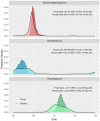Viral maintenance and excretion dynamics of coronaviruses within an Egyptian rousette fruit bat maternal colony: considerations for spillover
- PMID: 37739999
- PMCID: PMC10517123
- DOI: 10.1038/s41598-023-42938-w
Viral maintenance and excretion dynamics of coronaviruses within an Egyptian rousette fruit bat maternal colony: considerations for spillover
Abstract
Novel coronavirus species of public health and veterinary importance have emerged in the first two decades of the twenty-first century, with bats identified as natural hosts for progenitors of many coronaviruses. Targeted wildlife surveillance is needed to identify the factors involved in viral perpetuation within natural host populations, and drivers of interspecies transmission. We monitored a natural colony of Egyptian rousette bats at monthly intervals across two years to identify circulating coronaviruses, and to investigate shedding dynamics and viral maintenance within the colony. Three distinct lineages were detected, with different seasonal temporal excretion dynamics. For two lineages, the highest periods of coronavirus shedding were at the start of the year, when large numbers of bats were found in the colony. Highest peaks for a third lineage were observed towards the middle of the year. Among individual bat-level factors (age, sex, reproductive status, and forearm mass index), only reproductive status showed significant effects on excretion probability, with reproductive adults having lower rates of detection, though factors were highly interdependent. Analysis of recaptured bats suggests that viral clearance may occur within one month. These findings may be implemented in the development of risk reduction strategies for potential zoonotic coronavirus transmission.
© 2023. Springer Nature Limited.
Conflict of interest statement
The authors declare no competing interests.
Figures





Similar articles
-
Ecology, evolution and spillover of coronaviruses from bats.Nat Rev Microbiol. 2022 May;20(5):299-314. doi: 10.1038/s41579-021-00652-2. Epub 2021 Nov 19. Nat Rev Microbiol. 2022. PMID: 34799704 Free PMC article. Review.
-
Seasonal shedding patterns of diverse henipavirus-related paramyxoviruses in Egyptian rousette bats.Sci Rep. 2021 Dec 20;11(1):24262. doi: 10.1038/s41598-021-03641-w. Sci Rep. 2021. PMID: 34930962 Free PMC article.
-
Co-Circulation and Excretion Dynamics of Diverse Rubula- and Related Viruses in Egyptian Rousette Bats from South Africa.Viruses. 2019 Jan 8;11(1):37. doi: 10.3390/v11010037. Viruses. 2019. PMID: 30626055 Free PMC article.
-
Overview of Bat and Wildlife Coronavirus Surveillance in Africa: A Framework for Global Investigations.Viruses. 2021 May 18;13(5):936. doi: 10.3390/v13050936. Viruses. 2021. PMID: 34070175 Free PMC article. Review.
-
Detection and Characterization of an H9N2 Influenza A Virus in the Egyptian Rousette Bat in Limpopo, South Africa.Viruses. 2023 Feb 10;15(2):498. doi: 10.3390/v15020498. Viruses. 2023. PMID: 36851712 Free PMC article.
Cited by
-
Detection of an Alphacoronavirus in a Brazilian Bat (Molossus sp.).J Mol Evol. 2025 Apr;93(2):257-266. doi: 10.1007/s00239-025-10236-w. Epub 2025 Feb 17. J Mol Evol. 2025. PMID: 39961834
-
Synchronized seasonal excretion of multiple coronaviruses coincides with high rates of coinfection in immature bats.Nat Commun. 2025 Jul 17;16(1):6579. doi: 10.1038/s41467-025-61521-7. Nat Commun. 2025. PMID: 40675980 Free PMC article.
-
Gastrointestinal Shedding of Rubulaviruses from Egyptian Rousette Bats: Temporal Dynamics and Spillover Implications.Microorganisms. 2024 Dec 4;12(12):2505. doi: 10.3390/microorganisms12122505. Microorganisms. 2024. PMID: 39770708 Free PMC article.
-
Advances in understanding bat infection dynamics across biological scales.Proc Biol Sci. 2024 Mar 13;291(2018):20232823. doi: 10.1098/rspb.2023.2823. Epub 2024 Mar 6. Proc Biol Sci. 2024. PMID: 38444339 Free PMC article. Review.
-
Study of coronavirus diversity in wildlife in Northern Cambodia suggests continuous circulation of SARS-CoV-2-related viruses in bats.Sci Rep. 2025 Apr 12;15(1):12628. doi: 10.1038/s41598-025-92475-x. Sci Rep. 2025. PMID: 40221475 Free PMC article.
References
Publication types
MeSH terms
LinkOut - more resources
Full Text Sources
Medical

